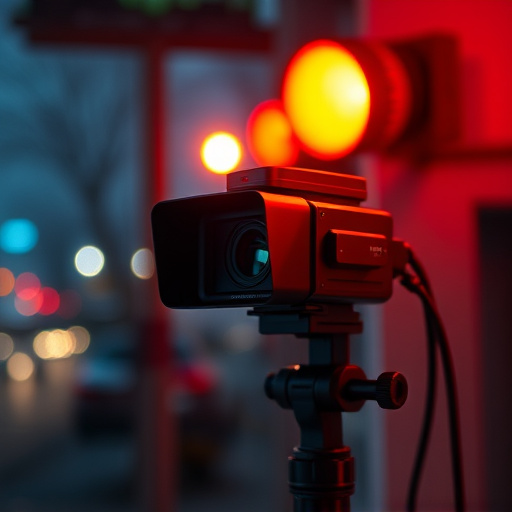Infrared (IR) camera technology has transformed home security with disguised cameras integrated into everyday items like lightbulbs or smoke detectors, providing clear images in darkness. IR camera detector apps leverage thermal imaging and machine learning to identify hidden cameras by detecting heat signatures, offering a simple yet effective way to enhance privacy and security. Users can download these apps, adjust settings, and strategically place cameras for monitoring, but it's crucial to prioritize ethics, transparency, consent, and robust app security to respect privacy rights while enjoying improved home protection.
Uncover the power of infrared camera technology with our comprehensive guide. Learn how specialized apps transform your smartphone into a powerful tool for detecting hidden cameras, offering enhanced visibility in today’s digital world. From understanding the science behind thermal imaging to mastering app settings for optimal home protection, this guide equips you to safeguard your privacy. We also explore critical privacy and security considerations, ensuring informed decision-making regarding disguised cameras for home protection.
- Understanding Infrared Camera Technology: Unveiling the Basics
- Detecting Disguised Cameras: How the App Works Its Magic
- Setting Up and Using the App for Optimal Home Protection
- Privacy and Security Considerations: Navigating the Ethical Landscape
Understanding Infrared Camera Technology: Unveiling the Basics
Infrared camera technology has transformed home protection and surveillance, offering a concealed yet powerful tool for peace of mind. Disguised cameras, often integrated into everyday objects like lightbulbs or smoke detectors, provide an advanced layer of security. These devices operate by detecting infrared radiation, allowing them to capture clear images even in complete darkness. Understanding how this technology works is key to harnessing its potential.
Infrared (IR) cameras function by converting heat energy into visible light, revealing what’s otherwise hidden from plain sight. Unlike traditional cameras that rely on visible light, IR cameras detect the natural heat emitted by objects, making them ideal for night-time use or monitoring areas with limited lighting. This technology is particularly valuable for home protection as it enables users to monitor entry points, deter potential intruders, and capture evidence without raising suspicion, thanks to their discreet design and operation.
Detecting Disguised Cameras: How the App Works Its Magic
Infrared camera detector apps are a powerful tool for identifying hidden or disguised cameras in your home, enhancing your privacy and security. These applications leverage advanced technology to detect heat signatures emitted by camera lenses, making them invisible to the naked eye. By scanning your surroundings with the app’s built-in thermometer, it can pinpoint the location of hidden cameras, whether they’re cleverly concealed behind paintings, clock radios, or other everyday objects.
The magic happens through a combination of thermal imaging and machine learning algorithms. The app captures temperature variations in its field of view, analyzing data to distinguish between heat sources. Disguised cameras, often using IR LEDs for night vision, create unique heat patterns that the app can recognize as potential threats. This technology ensures your home protection by making it easier to uncover hidden surveillance devices and take proactive measures against unauthorized monitoring.
Setting Up and Using the App for Optimal Home Protection
Setting up and using an infrared camera detector app is a straightforward process, making it an excellent tool for enhancing your home’s security. The first step is to download and install the app on your smartphone or tablet. Once installed, enable the app’s access to your device’s camera and necessary permissions. Many apps offer user-friendly interfaces, allowing you to easily adjust settings like sensitivity levels and scan frequency.
To maximize protection, place the device in a strategic location with a clear view of potential entry points. Disguised cameras designed for home protection can be placed in plain sight or hidden discreetly, ensuring they blend into the environment while remaining vigilant. The app will then begin scanning your surroundings, alerting you to any heat signatures or movements, providing an extra layer of security for your peace of mind.
Privacy and Security Considerations: Navigating the Ethical Landscape
When using an infrared camera detector app, it’s crucial to be mindful of privacy and security considerations, especially when employing disguised cameras for home protection. While these apps offer valuable tools for monitoring your surroundings, they can also raise ethical concerns if not used responsibly. It’s essential to understand that capturing and storing images or videos without consent may infringe upon individuals’ privacy rights, with legal implications varying across jurisdictions.
To navigate this ethical landscape, users should ensure transparency and obtain informed consent from anyone present in the monitored areas. Additionally, implementing robust security measures within the app is vital to protect personal data from unauthorized access. Regularly updating apps, using complex passwords, and enabling encryption can significantly enhance privacy safeguards. By adhering to these practices, you contribute to a responsible use of technology while reaping the benefits of enhanced home protection.
Infrared camera detector apps offer a powerful tool for navigating the world of hidden cameras, especially in the context of Disguised Cameras for Home Protection. By understanding infrared technology and following best practices for app usage, users can enhance their privacy and security. While ethical considerations must be taken into account, these innovative tools empower individuals to protect their personal spaces from potential surveillance. With proper guidance, you can leverage this technology to ensure a safer, more secure home environment.
